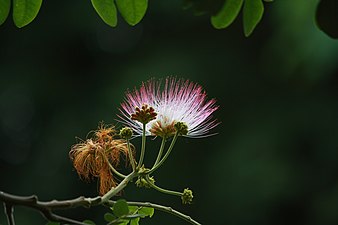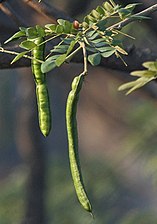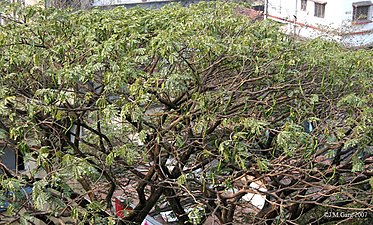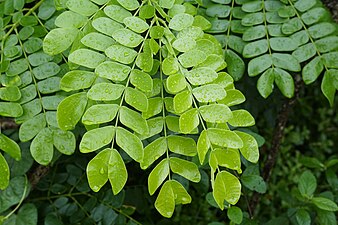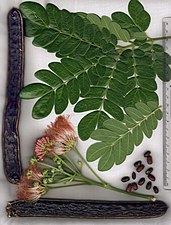Samanea saman
| Samanea saman | |
|---|---|
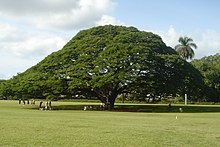
| |
| The Hitachi Tree at theMoanalua Gardens,Hawaii | |
| Scientific classification | |
| Kingdom: | Plantae |
| Clade: | Tracheophytes |
| Clade: | Angiosperms |
| Clade: | Eudicots |
| Clade: | Rosids |
| Order: | Fabales |
| Family: | Fabaceae |
| Subfamily: | Caesalpinioideae |
| Clade: | Mimosoid clade |
| Genus: | Samanea |
| Species: | S. saman
|
| Binomial name | |
| Samanea saman | |
| Synonyms[3] | |
|
List
| |

Samanea samanis a species offloweringtreein thepeafamily,Fabaceae,now in theMimosoid clade[5]and is native to Central and South America.[6]It is often placed in the genusSamanea,[7]which by yet other authors is subsumed inAlbiziaentirely.
Its range extends fromMexicosouth toPeruandBrazil,but it has been widelyintroducedtoSouth[citation needed]andSoutheast Asia,as well as thePacific Islands,includingHawaii.It is a well-known tree, rivaled perhaps only bylebbeckandpink sirisamong itsgenus.It is well represented in many languages and has numerous local names in its native range;[8]common English names includesaman,rain treeandmonkeypod[6](see also§ Namesbelow).
In Cambodia it is colloquially known as theChankiri Tree(can be writtenចន្ទគិរីorចន្ទ៍គីរី).
Description
[edit]
Tree
[edit]Saman is a wide-canopied tree with a large symmetrical umbrella-shaped crown. It usually reaches a height of 15–25 m (49–82 ft) and a diameter of 30 m (98 ft).[6]
This species of flowering tree in the Fabaceae family is native to Central and South America but has been widely introduced across the tropics, especially South and Southeast Asia.[citation needed]
Its branches have velvety and hairy bark.[9]Large branches of the tree tend to break off, particularly during rainstorms. This can be hazardous as the tree is very commonly used for avenue plantation.[citation needed]
A rain tree leaf is pinnate made of 6–16 leaflets, each leaflet is shaped like a diamond 2–4 centimetres (0.79–1.57 in) long and 1–2 centimetres (0.39–0.79 in) wide with a dull top surface and finely hairy beneath. The tree sheds its leaves for a while during dry periods.[6]Its crown is big and can provide shade, but allows rain to fall through into the ground beneath it.[9]
The leaves fold in rainy weather and in the evenings, hence the names rain tree and five o'clock tree.[10]
Flowers and seeds
[edit]The tree has pinkish flowers with white and redstamens,set onheadswith around 12–25 flowers per head. These heads may number in the thousands, covering the whole tree.[6]
Theseed podsof the tree are curved and leathery; they contain sticky, edible flesh covering the flat, oval seeds.[11][12]
-
Flower
-
A pollen grain
-
Pods
Names
[edit]InEnglishit is usually known as rain tree or saman. It is also known as "monkey pod", "giant thibet", "inga saman",[note 1]"cow tamarind",[13]East Indian walnut,[note 2]"soar", or "suar". In English-speaking regions of theCaribbean,it is known as coco tamarind inGrenada;French tamarind inGuyana;and samaan tree inTrinidad.[13]InPhilippine English,it is confusingly simply known as "acacia", due to its resemblance to nativeAcaciaspecies.[14]

The original name,saman- known in many languages and used for thespecific epithet- derives fromzamang,meaning "Mimosoideaetree "in someCariban languagesof northern Venezuela.[8]This name is also where its genus nameSamaneacomes from.[11]
The origin of the name "rain tree" is unknown. It has been variously attributed to local nameski hujanorpokok hujan( "rain tree" ) inIndonesiaandMalaysiabecause its leaves fold during rainy days (allowing rain to fall through the tree);[15]the way the relative abundance of grass under the tree in comparison to surrounding areas; the steady drizzle ofhoneydew-like discharge ofcicadasfeeding on the leaves; the occasional shower of sugary secretions from thenectarieson theleaf petioles;to the shedding ofstamensduring heavy flowering.[14]
In the Caribbean, it is sometimes known asmarsave.It is also known asalgarroboinCuba;guannegoul(e)inHaiti;andgoangoorguangoinJamaica.In French-speaking islands, it is known asgouannegoulorsaman.[citation needed]
InLatin America,it is variously known assamán,cenízaro,cenicero,genízaro,carreto,carreto negro,delmonte,dormilón,guannegoul,algarrobo del país,algarrobo,campano,carabeli,couji,lara,urero,orzarzainSpanish;andchoronainPortuguese.[14]
In thePacific Islands,it is known asfilingangain theNorthern Marianas;trongkon-mamesinGuam;gumorni spanisinYap;kasia kulaormohemoheinTonga;marmarinNew Guinea;ʻohaiinHawaii;tamaliniortamaligiinSamoa;andvaivai ni vavalangi,vaivai moceorsirsainFiji.[16]The former comes fromvaivai"watery" (in allusion to the tree's "rain" ) +vavalagi"foreign". In some parts ofVanua Levu,Fijithe wordvaivaiis used to describe thelebbeck,because of the sound the seedpods make, and the wordmocemoce(sleepy, or sleeping) is used forA. samandue to the 'sleepiness' of its leaves.[citation needed]
InSoutheast Asia,it is known asakasyaorpalo de Chinain thePhilippines;[14]mehortrembesiinIndonesia;pukul lima( "five o'clock tree" ) inMalaysiaandSingapore;[17][18]ampil barang( "Western tamarind" ) inCambodia;[19]ก้ามปู (kampu), ฉำฉา (chamcha), จามจุรีแดง (chamchuri daeng), จามจุรี (chamchuri) inThai;ကုက္ကို (kokko) inMyanmar;andcòng,muồng tím,orcây mưa( "rain tree" ) inVietnam.
InSouth Asia,it is known asshiriishainSanskrit;শিরীষ (shirish) inBengali;shirishinGujarati;सीरस (vilaiti siris) inHindi;bagaya marainKannada;ചക്കരക്കായ് മരം (chakkarakkay maram) inMalayalam;विलायती शिरीश inMarathi;marainSinhalese;தூங்குமூஞ்சி மரம் (thoongu moonji maram,"sleepy faced tree" ) inTamil;and నిద్ర గన్నేరు (nidra ganneru) inTelugu.[citation needed]
InMadagascar,it is also known asbonara (mbaza), kily vazaha, madiromany, mampihe,ormampohehy.[citation needed]
InEuropeanregions where the tree does not usually grow, its names are usually direct translations of "rain tree". These includearbre à (la) pluie(France),árbol de lluvia(Spain); andRegenbaum(Germany).[citation needed]
Use
[edit]The edible fruit pulp can be made into a beverage that tastes likelemons;the pulp is also an additive togasoline.[9]
Its wood is used for carving and making furniture.[6]
The "Samanea saman" tree is one of several types of host plants that allows lac insects (Kerria lacca) infestation. The resultant copious sap/insect discharge caused by this insect is a harden material that is subsequently collected and processed into lac/shellac and used in making lacquerware and wood finishes.
Raintrees around the world
[edit]In Cambodia
[edit]It is unclear when and how Chankiri was introduced to Cambodia. It is possible the tree was introduced from Brazil by the French in the 1920s, together with the rubber tree (Hevea brasiliensis) during the rubber industry's global boom in the early 1900s. It is also possible the tree came from neighboring countries in the region where the plant had been introduced earlier on by Western colonial explorers.[citation needed]
Since its introduction toCambodia,theSamanea samanis known locally aschankiri(ចន្ទគិរី). It has been widely planted across the country thanks to its tall height and expansive branches that can shade large areas, and as an ornamental. The fruit is eaten, and in famine times the young leaves are eaten in salads.[19]
Khmer:ចាមរី,romanized:Chamri[20]is the official Khmer name for the plant because the flowers from this tree resemble the beautiful long-haired tail of thechamri(known in English as yak).Ampil barang(French tamarind) is another colloquial name for it in Cambodia.
Chankiri Trees in the Killing Fields
[edit]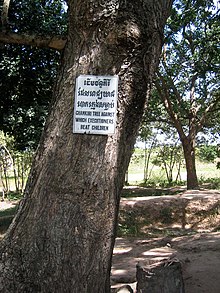
Since its introduction to Cambodia, Chankiri has been widely planted across the country thanks to its tall height and expansive branches that can shade large areas. Multiplechankirican also be found in theKilling Fields,an execution field used by theKhmer Rougeduring theCambodian genocide,though the trees were planted at the field long before. Children and infants with parents accused of crimes against the regime were smashed against trees, in the hope that the children "wouldn't grow up and take revenge for their parents' deaths".[21]
It was a coincidence that the Chankiri tree at the Killing Fields is one of the many trees against which the Khmer Rouge executioners beat young children and there are no specific associations locally between the Chankiri tree and the Khmer Rouge.[citation needed]
In Venezuela
[edit]WhenAlexander von Humboldttravelled in the Americas from 1799 to 1804, he encountered a giant saman tree nearMaracay,Venezuela. He measured the circumference of theparasol-shaped crown at 576 ft (about 180.8 m),[note 3]its diameter was around 190 ft (about 59.6 m), on a trunk at 9 ft (about 2.8 m) in diameter and reaching just 60 ft (nearly 19 m) in height. Humboldt mentioned the tree was reported to have changed little since theSpanish colonization of Venezuela;he estimated it to be as old as the famousCanary Islands dragon tree(Dracaena draco) ofIcod de los VinosonTenerife.[22]
The tree, calledSamán de Güere(transcribedZamang del Guayreby von Humboldt) still stands today, and is a Venezuelan national treasure. Just like the dragon tree on Tenerife, the age of the saman in Venezuela is rather indeterminate. As von Humboldt's report makes clear, according to local tradition, it would be older than 500 years today, which is rather outstanding by the genus' standards. It is certain, however, the tree is quite more than 200 years old today, but it is one exceptional individual; even the well-learned von Humboldt could not believe it was actually the same species as the saman trees he knew from thegreenhousesatSchönbrunn Castle.[8]A famous specimen called the "Brahmaputra Rain Tree" located at Guwahati on the banks of the Brahmaputra River in Assam, India has the thickest trunk of any Saman; approximately 12 feet (3.7 m) diameter at breast height (DBH).[23]The size of the pollen is around 119 microns and it is polyad of 24 to 32 grains.

Carbon sequestration
[edit]Carbon sequestrationis the capture and long-term removal ofcarbon dioxidefrom the atmosphere. According to a research conducted at the School of Forestry of theBogor Agricultural Institute,Indonesia,a mature tree with a crown diameter measuring 15 metres (49 ft) absorbed 28.5 metric tons (28.0 long tons; 31.4 short tons) of CO2annually. The trees have been planted in cities ofKudusandDemakand also will be planted along the shoulder of the road fromSemarangtoLosari.[24]
Gallery
[edit]-
Si Phan Don,Laos
-
Falling leaves inKolkata,West Bengal
-
Sukabumi,West Java
-
Detail of the leaves
-
Leaves, flowers, dried pods, seeds
-
Mature bark
-
Black-rumped flameback(Dinopium benghalense)
Notes
[edit]Footnotes
[edit]- ^Botanic Gardens Conservation International (BGCI) & IUCN SSC Global Tree Specialist Group. 2019.Samanea saman.The IUCN Red List of Threatened Species 2019: e.T144255307A148988354.https://dx.doi.org/10.2305/IUCN.UK.2019-2.RLTS.T144255307A148988354.en.Accessed on 01 March 2024.
- ^"Albizia saman.NatureServe Explorer 2.0 ".explorer.natureserve.org.Retrieved1 March2024.
- ^ab"Samanea saman(Jacq.) Merr ".Plants of the World Online.Royal Botanic Gardens, Kew.Retrieved3 March2020.
- ^Merrill, E.D. (1916).Journal of the Washington Academy of Sciences.6:47.
{{cite journal}}:Missing or empty|title=(help) - ^The Legume Phylogeny Working Group (LPWG) (2017)."A new subfamily classification of the Leguminosae based on a taxonomically comprehensive phylogeny".Taxon.66(1): 44–77.doi:10.12705/661.3.hdl:10568/90658.
- ^abcdefStaples, George W.; Elevitch, Craig R. (2006)."Samanea saman(rain tree) ".In Elevitch, Craig R. (ed.).Traditional Trees of Pacific Islands: Their Culture, Environment, and Use.Holualoa, Hawaii, USA: Permanent Agricultural Resources. pp. 662–664.ISBN978-0-9702544-5-0.
- ^"Samanea saman".Germplasm Resources Information Network.Agricultural Research Service,United States Department of Agriculture.Retrieved2010-03-25.
- ^abcvon Humboldt & Bonpland (1820): p.99 footnote
- ^abcArditti, Joseph; Mak Chin On (1999)."The Golden Rain Tree".Maryland Nursery.Archived fromthe originalon 15 Jun 2013.
- ^"Samanea saman (Jacq.) Merr".National Parks, A Singapore Government Official Website.
- ^abAllen, O. N.;Allen, Ethel K.(1981).The Leguminosae, a source book of characteristics, uses, and nodulation.Madison, Wisconsin, USA: University of Wisconsin Press. p. 590.ISBN978-0-299-08400-4.
- ^"Samanea saman (rain tree)".CABI Compendium.Centre for Agriculture and Bioscience International:4026. 22 September 2021.doi:10.1079/cabicompendium.4026.S2CID253665652.
- ^abAmong thelegumes,it is not very closely related totamarinds.
- ^abcdStaples, George W.; Elevitch, Craig R. (2006).Samanea saman(rain tree).Species Profiles for Pacific Island Agroforestry.
- ^Ahmad Azaruddin MN (4 June 2013)."Samanea saman: The umbrella-like rain tree".Colours of FRIM.Forest Research Institute Malaysia.Retrieved1 March2023.
- ^Keppel, Gunnar;Ghazanfar, Shahina A.(2011).Trees of Fiji: A Guide to 100 Rainforest Trees(third, revised ed.). Secretariat of the Pacific Community & Deutsche Gesellschaft für Technische Zusammenarbeit. pp. 204–5.
- ^Adnan Mohamad (2003).Pokok-pokok untuk tanaman bandar[Trees for town planting]. Kuala Lumpur, Malaysia: Forest Research Institute Malaysia. p. 111.ISBN983-2181-51-8.
- ^"Rain Tree".Gardens, Parks & Nature.National Parks Board.24 June 2021.Retrieved2 March2023.
- ^abPauline Dy Phon(2000).Plants Utilised In Cambodia/Plantes utilisées au Cambodge.Phnom Penh: Imprimerie Olympic. p. 174.
- ^Dictionnaire Cambodgien, Fifth Edition.Edition De L’Institut Bouddhique. 1967.
- ^Tyner, James A.; Philo, Chris (2009).War, violence, and population: making the body count.Guilford Press.p. 2.ISBN978-1-60623-037-4.
- ^von Humboldt & Bonpland (1820): pp.98-100
- ^<not stated> (November 4, 2012)."Landmark Trees of India".
- ^"Save the earth by planting Trembesi".
References
[edit]- Arditti, Joseph & On, Mak Chin(2004):The Golden Rain Tree.Version of 2004-MAY-01. Retrieved 2008-MAR-31.
- International Legume Database & Information Service (ILDIS)(2005):Albizia saman.Version 10.01, November 2005. Retrieved 2008-MAR-30.
- von Humboldt, Alexander&Bonpland, Aimé(1815):Reise in die Aequinoctial-Gegenden des neuen Continents(Part 3). J.G. Cotta, Stuttgart and Tübingen.Image/PDF fulltextatGoogle Books
External links
[edit] Media related toAlbizia samanat Wikimedia Commons
Media related toAlbizia samanat Wikimedia Commons Data related toSamanea samanat Wikispecies
Data related toSamanea samanat Wikispecies- Hawaiian Ecosystems at Risk Project page forSamanea saman
- Reference for Telugu word Nidra Ganneru



